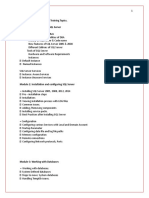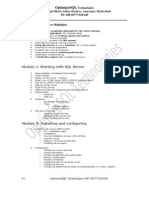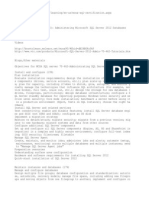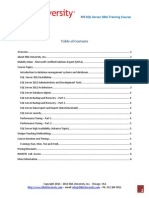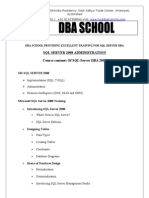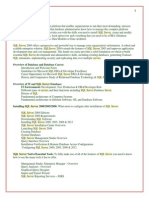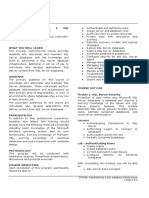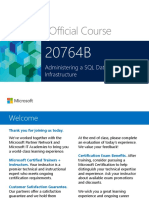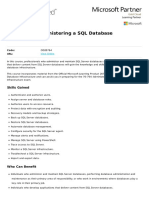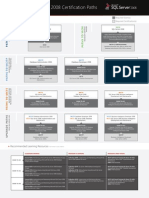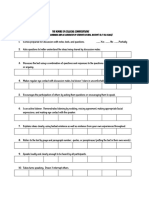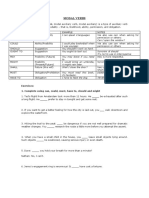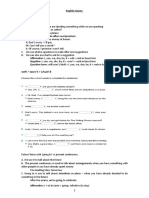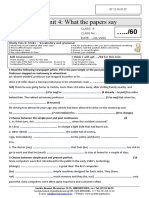Microsoft SQL Database Administrator Certification
Training for Exam 70-432 Course Modules and Objectives
www.SQLSteps.com
2009 ViSteps Pty Ltd, SQLSteps Division
Table of Contents
Module #1 Module #2 Module #3 Module #4 Module #5 Module #6 Module #7 Module #8 Module #9 Module #10 Module #11 Module #12 Module #13 Module #14 Module #15 Module #16 Module #17 Module #18 Module #19 Prerequisites for Installing Microsoft SQL Server 2008 Selecting Microsoft SQL Server 2008 Editions Installing Microsoft SQL Server 2008 Understanding SQL Server Files Managing the Database Managing Tables Working with SQL Server Indexes Partitioning Data Transferring Data Managing Security in SQL Server 2008 Implementing Layered Security Identifying Disaster Recovery Options Automating Tasks with SQL Server Agent Performance and Monitoring Optimizing Performance Understanding Failover Clustering Implementing Database Mirroring Implementing Log Shipping Implementing Replication 3 3 4 4 5 5 6 6 7 7 8 8 9 9 10 10 11 11 12
Microsoft SQL Database Administrator Course 2009 ViSteps Pty Ltd, SQLSteps.com Division
Course Modules and Objectives
Module 1:
Prerequisites for Installing Microsoft SQL Server 2008
Outline the Business Scenario Case Study Identifying minimum hardware requirements Understanding the Processor and Memory Prerequisites Understanding the Disk Space Prerequisites Identifying Supported Operating Systems Identifying Software Requirements
Module 2:
Selecting Microsoft SQL Server 2008 Editions
Explain SQL Server services Understand the types of SQL Server services - Service Broker Service - SQL Server Integration Service (SSIS) - SQL Server Reporting Service (SSRS) - SQL Server Analysis Service (SSAS) Identify the need for different SQL Server editions List the different editions of Microsoft SQL Server 2008 Identify the differences between the various SQL Server editions
Microsoft SQL Database Administrator Course 2009 ViSteps Pty Ltd, SQLSteps.com Division
Module 3:
Installing Microsoft SQL Server 2008
Create Service Accounts Understand the SQL Server Configuration Manager Understand SQL Server Instances Set Authentication Modes Install and Configure a SQL Server Instance Install a Sample Database Configure Database Mail
Module 4:
Understanding SQL Server Files
Understand types of SQL Server files Understand Filegroups Work with Filegroups Understand Transaction logs Manage Transaction logs Understand the FILESTREAM feature Understand the tempdb database
Microsoft SQL Database Administrator Course 2009 ViSteps Pty Ltd, SQLSteps.com Division
Module 5:
Managing the Database
Describe the available database options Discuss the various recovery models Set the recovery model Automate actions in a database Understand change tracking Control database access Understand query parameterization Understand collation sequences Ensure database integrity
Module 6:
Managing Tables
Understanding Database Schemas Understand Data Types; Numeric, Character, Date and time, Binary, XML and Spatial data types Understand properties of table columns Understand computed columns Compress rows and pages to reduce disk storage space Create tables Understand table constraints
Microsoft SQL Database Administrator Course 2009 ViSteps Pty Ltd, SQLSteps.com Division
Module 7:
Working with SQL Server Indexes
Understand the Index Structure Discuss different SQL Server Indexes; Clustered, Nonclustered, Unique, Index with included columns, Filtered, XML, Spatial and Full text Indexes Work with and Implement Indexes Understand what is Index fragmentation Manage Indexes Work with Full Text Indexes
Module 8:
Partitioning Data
Understand Partitioning Implement Partition functions Implement Partition schemes Create Partitioned tables Create Partitioned indexes Manage Partitions
Microsoft SQL Database Administrator Course 2009 ViSteps Pty Ltd, SQLSteps.com Division
Module 9:
Transferring Data
Identify data transfer tools for Importing and Exporting data Understand and use the Bulk Copy Program (BCP) Understand and use the BULK INSERT command Understand and use the SQL Server Import and Export Wizard
Module 10:
Managing Security in SQL Server 2008
Understand Policy-Based Management Understand the terms associated with Policy-Based Management Describe the Policy-Based Management process Identify how Policies are evaluated Create your own Policy Manage policies across multiple instances of SQL Server Import and export policies across database instances
Microsoft SQL Database Administrator Course 2009 ViSteps Pty Ltd, SQLSteps.com Division
Module 11:
Implementing Layered Security
Understand what are Endpoints Describe Endpoint Configuration for Database Mirroring and Service Broker Create an Endpoint for Database Mirroring and Service Broker Understand Surface area configuration Manage Protocols, Connections and Startup Options Work with Principals Describe Certificates and Asymmetric Keys Manage Permissions Audit SQL Server instances Encrypt data in SQL Server
Module 12:
Identifying Disaster Recovery Options
Understand database backups Understand transaction log backups Manage corrupt pages Understand the maintenance plan Validate backups Restore database backups Restore corrupt pages Restore databases with media errors Restore transaction Log Backups Work with database snapshots
Microsoft SQL Database Administrator Course 2009 ViSteps Pty Ltd, SQLSteps.com Division
Module 13:
Automating Tasks with SQL Server Agent
Understand the SQL Server agent Manage SQL Server Agent Jobs Understand operators Define SQL Server alerts Understand what are performance condition alerts Understand Windows Management Instrumentation (WMI) event alerts
Module 14:
Performance and Monitoring
Understand the System Monitor Work with Counter Logs Work with Performance Counters Work with SQL Server Profiler Create a Trace Manage Traces Jointly Analyze SQL Server Profiler and System Monitor Data Work with Logs Manage Space for Logs and Databases Identify Reasons for Service Failure Work with Locks
Microsoft SQL Database Administrator Course 2009 ViSteps Pty Ltd, SQLSteps.com Division
�10
Module 15:
Optimizing Performance
Understand the Database Engine Tuning Advisor Work with Database Engine Tuning Advisor Understand the process of workload analysis Set the Database Engine Tuning Advisor options Work with Resource Governor Determine Resource Governor configuration Implement the Resource Governor Work with Dynamic Management Views and Functions Work with Performance Data Warehouse
Module 16:
Understanding Failover Clustering
Understand Failover Clustering Design Failover Clustering Design Windows Clustering Configure Windows Clustering Configure Failover Cluster Instances Perform Cluster Health Checks
Microsoft SQL Database Administrator Course 2009 ViSteps Pty Ltd, SQLSteps.com Division
�11
Module 17:
Implementing Database Mirroring
Understand Database Mirroring Describe Database Mirroring Operating Modes Prepare Databases for Mirroring Copy System Objects from the Principal to the Mirror Understand Failover Design Database Mirroring Failback
Module 18:
Implementing Log Shipping
Understand Log Shipping List the Participants in Log Shipping Configure Log Shipping Understand Failover Strategies Understand Failback Strategies
Microsoft SQL Database Administrator Course 2009 ViSteps Pty Ltd, SQLSteps.com Division
�12
Module 19:
Implementing Replication
Understand Replication Understand different Replication methods Describe what are Replication Agents Resolve Data Conflicts Implement Snapshot Replication Implement Transactional Replication Implement Merge Replication Microsoft Test Preparation
Microsoft SQL Database Administrator Course 2009 ViSteps Pty Ltd, SQLSteps.com Division



